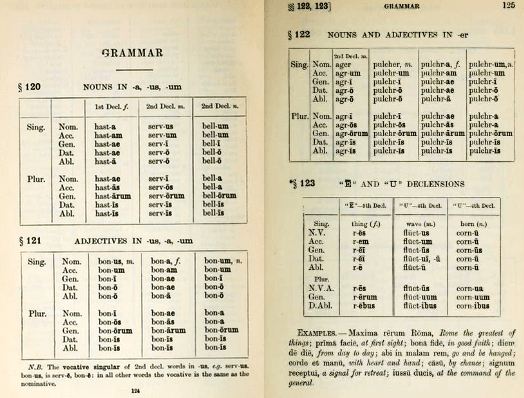…almost everything–quite a lot! That’s why there are so many. That’s why it’s so essential to recognize the various noun forms. And, that’s why generations of schoolmasters have had generations of students chanting and memorizing and parsing–the sense of a Latin sentence is found in these noun endings!

Beginners to Latin are often confounded by the multiplicity of the endings and charts of word parts in Latin textbooks. What is all this for? Couldn’t we all just do without it? In English we do indeed mostly do without noun endings, but Latin…can’t. So let’s zoom in and see what’s going on here.
Today let’s look at what these charts of noun endings actually tell us: which job each noun does in a sentence. (I’ve explained a little about things verb endings tell before, if you’re interested.) We shall use 1st Declension endings in our sentences, which you may have seen before.
First, a few Latin words to know:
| Verbs: | canto = I sing cantamus = we sing dono = I give donamus = we give est = is sunt = are laudo = I praise laudamus = We praise |
| Nouns: | corona = crown filia = daughter gratia = grace, gratitude Graecia = Greece Italia = Italy regina = queen terra = land |
| Conjunction: | et = and |
| Prepositions: | cum = with pro = for |
(How good is your grammar, by the way? Quick review of terms: the Subject of a sentence does the main action. The Direct Object is the one who receives the action, as it were. The Indirect Object is another thing or person also involved in the action. Ownership or possession tells to whom something belongs, of course. When you are calling out to a person, he is the person addressed. And a preposition is a word telling us where or when–above, across, by, down, during, &c., &c.)
Now, to see the jobs the various endings do:

Perhaps you noticed above that the ending “-ae” appeared in the chart four times, and “-a” three times. It may seem like it must be very difficult to keep this straight, but context gives the clues to make it work out. Particularly, the verbs indicate what the nouns are “doing,” and then the nouns’ endings ultimately clinch the case.
Well, I hope this helped to demystify those Latin noun tables a little for you! (Bonus: this all applies to adjectives and pronouns too, by the way!) If you would like to print the above sentences page, it’s here and in the sidebar. I’d love to hear what you think about it, if you have a minute.
Here’s to lots more Latin learning, and lots less fear!

Thank you Magistra Stella Very helpful!
Gratias Tibi
Keep it coming!
Walt L.
LikeLike
Et tibi gratias! I sure will!
LikeLike
Can the dative ending for Deus (God)i.e. “Dei” mean “in God”?
LikeLike
Salve! The form”Deo” is both dative (for indirect object) and ablative (with many prepositions), so that one can indeed mean “in God.” (“Dei” is “of God,” the genitive/possessive form.)
LikeLike